Over the past several weeks, I’ve been hard at work building the second season of the Hashtag Higher Ed Podcast. This podcast has become a real labor of love for me in my daily role at Electric Kite. Podcasting is more than a medium for me; it is a valuable opportunity to meet new colleagues, build relationships, and empower the higher education marketing community.
That pursuit will continue in season two. In the coming weeks, the Hashtag Higher Ed Podcast will feature incredible guests at schools like Georgia Tech, Sweet Briar College, the University of Minnesota, and Harvard University, among others. Together, we’re discussing stories behind new projects, insights into their professional role, and exploring new higher education marketing trends.
Before I pressed record on season two, I presented data and insights from season one to the Electric Kite team. In doing so, I noticed several themes that directly impacted the success or limitations of the podcast. And if I’m committed to anything as a marketing professional, it’s transparently sharing experiences and lessons learned to others who may be launching similar projects.
So, without further ado, here are five lessons learned from the first season of the Hashtag Higher Ed Podcast.
1. Audio Quality is Everything
Let’s start with the obvious. It should go without saying that if you’re launching a podcast, you need to invest in sound quality. But too often, audio quality is equated with microphones and microphones alone. In reality, audio quality is the result of several factors. In fact, for the Hashtag Higher Ed Podcast, we invested a mere $32 on a microphone for the show, choosing the ultra-portable Samson Go Mic.
Instead, the location in which you record is often just as, if not more, impactful on audio quality. This is something I learned first hand in season 1. In episode three, for example, featuring Bloomfield College’s Adam Castro, I made the mistake of recording in an empty office, which created an echo effect that was hard to limit in post-production. In episode 11 with Purdue University, I unexpectedly needed to work from home on recording day. The result, a DIY recording studio in my bedroom closet, resulted in some of the best sound quality I produced all season.
Of course, as a host, my podcast really isn’t about me; it’s about my guests. And since they do most of the talking, their audio quality is arguably more important than mine. In fact, we’ve noticed a direct correlation between audio quality and show downloads. That was never more noticeable than when evaluating episode 13, featuring JP Rains from Laurentian University. JP was an over-achieving podcast guest who, in preparation for his podcast appearance, purchased the same Samson Go Mic that has served me well. The result was clear audio on both sides of the show, and impressive retention statistics – an important statistic considering JP’s episode was among the longest of the season.
The Takeaway
Don’t leave your audio to chance. Educate your guests on best-practice recording logistics. I try to send podcast guests an email several days in advance of our recording time suggesting microphone options, reminding them of the importance of wearing headphones, and asking them where they plan on recording. Asking these questions in advance makes your guest consider important logistical matters they may not otherwise consider until it’s too late to make adjustments.
2. Create Structure, Not a Script
Since the Hashtag Higher Ed podcast format is based on a direct Q&A between two (or more) individuals, preparation is critical. That’s why one week before my recording date, I send podcast guests my proposed themes for the show and a set of preliminary episode questions.
By sending questions to guests ahead of time, my guest and I are able to agree on discussion points well before we record. This document also provides my guests with the opportunity to think through their responses and organize their thoughts before the blinking red record light begins.
Of course, not every guest puts in the time and effort to write down brief outlines of their responses. But for those who do, I’ve noticed a clear correlation in episode quality.
Importantly, while I push guests to structure their answers, I make it clear that I’m not looking to create a script for an episode. I set clear expectations about what I expect in return when sending preliminary questions. In the accompanying email, I ask guests to outline their thoughts with short blurbs or bullet points, rather than writing out their full responses. This helps prevent a situation in which a podcast guest ends up reading their responses to questions on air. The goal is to record an episode that is structured, but not scripted.
The Takeaway
Set your guests up for success. For many guests, podcast appearances are an opportunity to promote themselves, their recent work, and their organizations. If they don’t know what you’re planning to discuss on the show, they will be less likely to represent themselves to their full potential. Talking off the cuff is also more likely to lead to rambling, verbal pauses, and re-records, which will make your job as a podcast host (and potentially an editor) more difficult and time-consuming.
3. Consistency is Key
One podcasting lesson I learned the hard way is the importance of a consistent publishing schedule. When I started planning the Hashtag Higher Ed Podcast, I chose a bi-weekly publishing schedule because it seemed more realistic and easier to manage than the weekly production schedule that so many of my favorite podcasts followed.
And while that was certainly true, there were still times during the year where I struggled to maintain a consistent publishing schedule. In reality, I was able to maintain a consistent bi-weekly publishing schedule for the first six episodes of the season, before succumbing to distractions and other job responsibilities. For the duration of the season, I ended up publishing every 2-4 weeks.
In looking at data from season 1, it’s hard not to think that the show suffered from that inconsistency. While I saw substantial growth in listenership between the show’s podcast debut and season finale (the season finale had 500% more listens in the first two weeks than the season debut,) listenership grew in a more linear fashion during the first six episodes of the season before taking on a bit more of a rollercoaster pattern later in the season.
Of course, consistency is about more than just a publishing cadence. In season 1 of the podcast, I tried to focus on all elements of higher education marketing. The goal in doing so was to cast a wide net, both in terms of audience and guest potential.
Considering our initial goals, this approach was a success. But I also can’t help but feel that these wide-ranging episode topics held the show back from gaining a truly loyal audience, which is a hallmark of podcasting as a medium.
For example, in episode 9, I hosted individuals from Butler University to talk about their innovative yield marketing tactics from the spring. A few weeks later, in episode 13, I welcomed clients from George Washington University to discuss their recently-closed $1 billion fundraising campaign. While these were both wonderful episodes on their own, they were relevant to largely different audiences. Simply put, I wasn’t giving any one audience a reason to consistently tune in (beyond the talents of the host, which let’s be honest, were, and remain, limited.)
So how am I adapting? In season 2, I’m narrowing the focus of the show, focusing more on enrollment marketing and even within that topic, the various ways higher education marketers are using content to attract prospective students, convert them into applicants, and nurture them into enrolled students.
Will doing so limit our audience size? Potentially. Will doing so also create a more loyal and engaged audience? I’m optimistic that it will.
The Takeaway
Before launching a podcast, take the time to consider your larger business goals and how you can best meet those goals with a podcast. This is especially relevant for anyone starting a podcast in higher education, where it can be tempting to create a show that promotes the university to prospective students, current students, alumni, and even local media.
I urge you to resist that temptation. Don’t try to be all things to all audiences. Rather, choose a single audience based on your institution’s goals, make it your mission to understand that audience’s goals, challenges, and pain points, and craft a program based on that information. Your initial audience may be smaller, but the audience you do attract will be a much more engaged audience. And if you stay dedicated to your audience and goals, I promise that you’ll grow that audience over time.
4. Create a Consistent Format
Like most podcasts, the Hashtag Higher Ed podcast started as a humble, self-funded podcast. But while the show wasn’t supported by ads and sponsors, we made a conscious decision to insert musical interludes into the show and make our “Social Shout Out” segment of the show a recurring segment.
Doing so accomplished a few objectives. First, by setting up the show with musical interludes, we created natural breaks in the show that would support future promotions and sponsorships if and when these additions were appropriate.
That decision proved prescient, as in season 2, I’ll be using one of those musical interludes to promote Hashtag Higher Ed’s inclusion in the recently formed podcast network, ConnectEDU.
In subsequent interludes, we’re making a concerted effort to be more proactive about promoting Electric Kite and any new pertinent reports, case studies, or articles we’ve released. And by using existing interludes, we’re creating natural additions to the show that won’t feel jarring to listeners who are already used to breaks in dialogue.
Consistent formats are a sign of an established show and can create a sense of familiarity with your audience. I want my audience to feel excited about fresh dialogue with each new episode, but I also want them to know what to expect in terms of the format of that dialogue.
Consider the alternative. If every episode of your show was different, your audience wouldn’t know what to expect in any given episode, making it difficult to set expectations and look forward to specific segments of your show. Over time, that would decrease the likelihood that your audience would come back consistently. That’s especially important in a medium that is still somewhat new but becoming more crowded every month.
Expectations are partly why we kept the “Social Shout Out” part of the show a consistent segment on the show. Introducing this segment is a clear signal to our audience that the episode is nearing its end, which I believe makes it easier to continue listening to the show, rather than pausing an episode because someone is unclear about how much longer the episode will continue.
The Takeaway
Begin as you mean to finish. Don’t just plan for your first five episodes – carefully consider what you want your podcast to look and sound like in subsequent seasons and episodes. You may not host a powerhouse podcast right now, but in order to get there, you need to act like one.
5. Go Beyond Audio
In kicking off season 1 of the Hashtag Higher Ed Podcast, one of the items I tried to be very realistic about was the time commitment of producing a podcast. Essentially, how could I best maximize the impact of the show and promote it across our various owned marketing channels, thus justifying the agency’s substantive time commitment?
As part of this thought process, I committed to publishing an accompanying blog post for every podcast episode. Doing so, I hoped, would earn more impressions for the show across multiple platforms.
Early in the season, these articles existed as short, roughly 600-word summaries of each respective episode. I didn’t necessarily want to summarize the entire episode in these articles; I wanted to use the blog as a promotional channel and tease readers into listening to the show.
But as the season progressed, I found myself naturally gravitating towards fully educational, value-add articles based on podcast content. These articles regularly tipped the scales at more than 1,000 words and were written to not only inform podcast listeners of new episodes, but attract organic traffic to our website from individuals who were interested in the content we were producing on the podcast but were not yet aware of its existence.
As a result of this effort, I, along with my colleague and writer extraordinaire Melissa Bischoff, more than doubled the digital footprint of the podcast. The articles published on our website equaled season listenership, plus an additional 1,000+ pageviews.
Most interesting, however, was the fact that as our season progressed, certain episodes began to perform better as articles than they did podcasts. For example, early in the season, we released an incredibly popular episode featuring a four-guest panel about social media takeovers. However, the accompanying blog post, one of our high-level synopses, was among the worst performing podcast articles.
On the opposite end of the spectrum, our article about George Washington far exceeded the audio version of the episode, partly on the basis that the article was written in a way that continued to accrue pageviews long after the audio version of the story had stopped generating playback.
Beyond the specific insights gained from additional article data, simply being able to examine another layer of analytics has been incredibly beneficial. Podcasts are notoriously limited in their analytics, though that situation has improved in recent months. Being able to look at related content and context, like article pageviews, CTA rates on those articles, and email open and CTR rates in which podcasts are featured, has provided our team with an additional level of confidence in our review of each episode and the impact of the podcast at large.
The Takeaway
The final product of a podcast series can often look like a simple collection of 30-60 minute recorded conversions. This can lead many to feel like they can jump into the medium with minimal investment. The reality, of course, could not be further from the truth. Between guest research and scheduling, episode prep time, recording time, and post-production time; hosting a podcast is a lot of work.
And while it may seem counterintuitive to add an additional layer of work into the equation by writing accompanying blog posts, these articles, or other types of accompanying content, can help you expand the digital footprint for your podcast and grow your audience beyond audio, while capturing meaningful engagement data that can help you pitch for more resources, secure a sponsor, or prove its merit.
Producing a podcast is playing the long game. Unlike a single marketing entity, like an article, video, or even a white paper, a podcast series is a promise to your audience of regularly produced, fresh content. And while fulfilling that promise requires a consistent approach to content production, taking an occasional step back and reviewing your show from 10,000 feet can be beneficial.
Personally, breaking down the Hashtag Higher Ed podcast into seasons has provided a natural opportunity to step back, review, and improve the show. In a way, so has writing this article. Now, I want to hear from you. Have you produced a podcast? Or have you listened to the Hashtag Higher Ed podcast? Shoot me a note on Twitter and let me know what you think or what you’ve learned from producing your own show.



